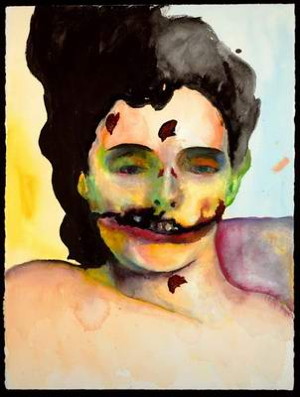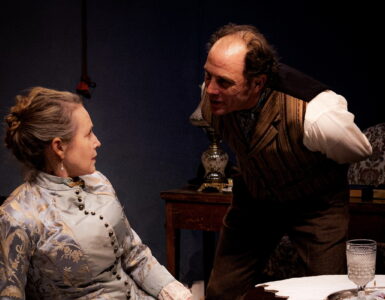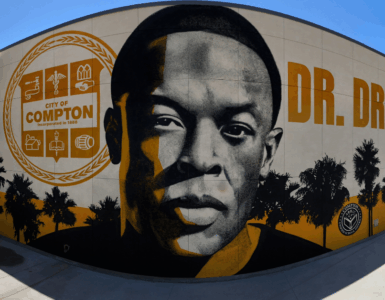Freshly released into the ether (interwebs) is my latest feature article for LA Stage Times, an interview with artist and goth-rocker David J about his spooky new musical play,
“The LAPD knew that this guy was a slippery customer. Whoever came in as new police commissioner wouldn’t want the first big crime that they had to solve to be botched. Rather than risk that, they let him go. Plus, there was the vested interest from his influential pals that he was untouchable. He knew all their names and numbers.”
Featuring a dazzling combination of drama, song, visual projection, fine art and dance, in his musical play The Chanteuse and the Devil’s Muse, artist David J, poses an astonishing and chilling theory regarding the identity of a cold case killer.
One of Los Angeles’ most notorious, gruesome and unsolved crimes occurred early 1947 when the disfigured remains of a young woman named Elizabeth Short were found in a vacant inner city lot, in LA’s Leimert Park. The twenty-two year old wanna-be actress had been sexually assaulted, tortured, viciously mutilated and – most shockingly – severed in two.
She was dubbed ‘The Black Dahlia’ by the sensation-hungry press because of her fair skin, wavy jet-black hair and preference for mysterious black attire. The moniker was also a dark twist on the title of a Raymond Chandler scripted murder mystery, The Blue Dahlia, which had just been released in cinemas.
Like London’s turn-of-the-century Ripper killings, this grisly and incomprehensible murder created a frenzy of speculation and morbid fascination in a society still reeling from the grim revelations from the end of World War II. Interest in the murder was reignited in 1987 by James Ellroy’s crime novel, which is a fictional account inspired by those actual events. Brian De Palma also filmed a studio picture in 2006, based on the cold case and Ellroy’s novel.
Now we have David J’s theatrical take, which adds a further degree of fictional separation blended with recently unearthed facts from the real-life cold case. Shedding new light on the ‘Black Dahlia’ saga, David J’s spooky play with live music, The Chanteuse and the Devil’s Muse, explores the legend of this murder mystery and creates a kaleidoscope of passion and dark obsession.
Goth-rocker.
Tall and lanky, his short hair dyed corn-yellow blond, in person the 54-year-old musician emanates a slightly mysterious vibe thanks to his serious and penetrating gaze. David J. Haskins (born 24 April 1957 in Northampton, England), better known as David J, is a British alternative rock musician. He was the bassist and shared songwriting and vocal duties for the rock band Bauhaus (formed in 1978) and later Love and Rockets (formed in 1985). With their dark and gloomy sound and image, Bauhaus are generally considered the first gothic rock group.
A prolific artist of many disciplines, including composer, musician, singer, playwright, screenwriter and fine artist, David J has both a new album being released mid-October called ‘Not Long For This World’ as well as his play hitting the stage this month.
David J says the new album and his play are completely separate entities, but allows a connection. “There is a resonance, in that it’s an album about mortality. On the album I do a Tom Waits cover, called Dead and Lovely, which could be the story of Elizabeth Short. I toyed with the idea of maybe including it in the play but decided against it.”
With his previous theatrical work Silver for Gold (The Odyssey of Edie Sedgwick), David J brought the story of Warhol muse, Edie Sedgwick, to the Los Angeles stage to critical acclaim, enjoying a brief run at the Met Theatre in 2008.
Origins of The Chanteuse and the Devil’s Muse.
Interspersing scenes of a police interrogation, David J’s multi-media and multi-discipline play features some instrumental music as well as a song cycle that is poetically and thematically related to form a unified work. In this theatrical staging, the music works as a framework around which another related story is interwoven, that of torch singer Madi Comfort.
The genesis of this play is the ‘Black Dahlia’ song cycle that David J originally composed, in collaboration with musician Ego Plum, for an independent feature film The Devil’s Muse in 2007. Explains the artist, “How it came about was that I was approached by the director of that film, Ramzi Abed, who wanted me to write some new music for an experimental movie. He said his was a very surreal treatment of the Black Dahlia mystery. I was familiar with that murder case, but not overly so. When I started to research it, it really caught fire and I started writing these songs, one after the other, just tumbling out of my subconscious. I became obsessed with it. I wrote all the music without seeing the film.”
That movie was the catalyst for this song cycle, some of which was written with Ego Plum; David J wrote all the words but the pair collaborated on the music. David then refashioned that song cycle into this musical play, The Chanteuse and the Devil’s Muse.
He muses, “I always thought those songs had another life beyond that film. Then I was approached by a producer, Helene Federici, who makes her own operas that combine electronic music and opera called electropera.” Federici wanted to stage a one-off evening of performance, at the legendary 3rd and Broadway Million Dollar Theatre, in Downtown LA, of one of her operas but wanted to stage a double-bill, called Theatrefication. She gave David J carte blanche to do “whatever I wanted, something theatrical. But I had no idea what I wanted to do. So I set my subconscious a task, to tell me what to do – I do this sometimes – and I went to sleep with that intention. At three o’clock in the morning, on the dot, I woke up and thought, I don’t know why but it has to be the Black Dahlia!”
That next morning he received an email from a musician friend, Joyce Rooks, who had played cello on the original surreal movie soundtrack. “Just out of the blue I get this email with a link and the heading is, ‘Whittier woman connection to the Black Dahlia murder.’” Astounded by the synchronistic connection, David J took it as a sure sign he was on the right creative path.
According to David J, the 2010 newspaper article claimed that Comfort, who died in 2003, had a connection with the Black Dahlia. “Apparently she made a deathbed revelation that all these years, since 1950, she’d harbored the secret that she knew her paramour, George Hodel, was indeed the murderer. That’s when I realized I had the dramatic content – this jazz singer.”
For his imaginative theatrical staging, David J’s musical framework is melded together by the narrative of torch singer Madi Comfort. Blending fantasy and fiction with some existing facts, the drama of the play is centered around a real-life police interrogation where cops interviewed singer Madi Comfort, a historical figure in the real case whose paramour, George Hodell, was one of the prime suspects in Short’s sadistic murder.
Further research into the true crime revealed that Comfort had been interviewed by a lieutenant in the DA’s office called Frank Jemison. “I knew I could write this so that the songs lead into the dialogue and vice versa, and link it all up like that. There’s hardly anything on record that came from that actual interview – just a few lines – so I imagined what it would have been and used it to tell the story. It’s my imagining of what that interview could have been.”
David J says he knows that although the detective, Lieutenant Frank Jemison, was being leaned on very heavily by the LAPD, he refused to bow down. “So this creates a dynamic of a cop who won’t toe the line, who is motivated to bring this guy in because it’s the right thing to do.”
The playwright says he read everything he could get his hands on, including James Ellroy’s book. But he maintains his main source material was Black Dahlia Avenger by Steve Hodel, a former LAPD homicide detective. In 2003 one of George Hodel’s sons, Steve Hodel, published a book claiming his father, who died in 1999, had in fact committed the Black Dahlia murder as well as a host of unsolved murders over the better part of two decades.
Recalls David J, “I had a meeting with Steve, and actually he’s been quite instrumental in the development of this play. He told me that there were a couple of reasons the cops let the case go cold. George Hodel was the head VD doctor in LA County and he quietly took care of abortions as well. Apparently he would fix things for high-up politicians, top policemen and studio executives and take care of their mishaps with young starlets, keep all that hush-hush. So George was the golden-boy. They didn’t want him to be put away because he was providing such a necessary service.”
The police, it seems, were never actually interested in solving the case…
Musical interludes and dance sequences.
A blend of drama with music, some of the music will be performed live by a small three-piece band while several cues are pre-recorded. David J will play guitar on one song and sing vocals. His collaborative writing partner Ego Plum, plays keyboards, drums and performs backing vocals. “We also have Ysanne Spevack on strings, playing cello, viola and violin. She’s pretty amazing.”
The role of Madi Comfort will be played by Daniele Watts (two-time NAACP Award-winner and Ovation Award nominee), with Tracey Leigh (Obie Award-winner) making special appearances in the role throughout the run. Douglas Dickerman will play the part of Lieutenant Frank Jemison.
David J enthusiasm builds as he describes his project coming together. “There’s a real cohesion now between the dialogue, the songs and the instrumental pieces and there are a couple of set routines.” In a macabre dance sequence, two women will portray the severed corpse, adding a dream-like element to the drama. “I want it to be strangely beautiful but not overtly sexual – just disturbing.”
The surreal factor of Butoh.
The Chanteuse and the Devil’s Muse will also feature a performance by the extraordinary, internationally acclaimed Butoh performer, Vangeline.
Butoh is the outré, avant-garde dance movement that developed in mid-20th-century Japan as a response to the inconceivable horror and mass-murder of WWII – specifically the atomic bombs that devastated the cities of Hiroshima and Nagasaki and killed hundreds of thousands of Japanese civilians.
This modern dance form typically involves playful and grotesque imagery, sometimes taboo topics, extreme or absurd environments, and is traditionally performed in white body makeup with slow hyper-controlled motion.
Embodying the tormented spirit of Elizabeth Short, Vangeline’s performance will linger in the periphery of the play until her presence slowly builds to a cathartic climax. Explains David J, “Vangeline is an amazing performer. She’s on right from the start until the end and she does a fifty-minute transit throughout.”
Vangeline will represent the ghost of Elizabeth Short, newly deceased although she doesn’t realize it. “She’s disorientated. She’s just gone through this unimaginable hell, and she’s out the other side and is trying to get her bearings. Gradually she realizes she is dead and goes towards and into the light and heads off but she returns for the finale, and in a cathartic way she relives her murder. Sometimes she’s the entire focus and there will be instrumental pieces that she’s performing to, but during the interrogation she’s more of a presence, barely moving.”
David J emphasizes the essential element of emotional purification or purgation of Butoh, adding, “People think Bauhaus was all about wallowing in the darkness, but it was more about facing the darkness and, through the process of catharsis, emerging out the other side.”
Lobby Art Show.
Controversial musician Marilyn Manson had created a series of watercolor paintings inspired by the autopsy photos of the ‘Black Dahlia’ crime and offered to exhibit them in tandem with the play. But it transpired that Manson had forgotten that all of the artworks had been sold. One of the paintings had been purchased by Flea (the bass guitarist of the rock band Red Hot Chili Peppers) and, because they have a personal relationship, David J asked Flea if he’d consider loaning it for the run of the play. Flea agreed and so one of Manson’s watercolors will be on display in the Bootleg Theatre lobby, along with some collage-style artwork that David J created during his research.
An enduring mystery.
This ghastly murder is the quintessential LA mystery; it’s gruesome, it’s perplexing and it has so many riveting elements. Does David J understand why it is so fascinating? “A lot of it is to do with the atmosphere of the time. It’s a living slice of film noir. She was very glamorous and had a particular ‘look,’ hence the name. Pale skin, jet black hair, dark, sophisticated clothes and white flowers in her hair – such a striking image.” Then there’s the mystery of the murdered woman herself, the fact that she wasn’t really known. Adds David J, “She didn’t make her mark on the world, and so she was like a blank screen on which one can project whatever you want. It’s ironic that she craved fame, she wanted to be a movie star, and she achieved fame but only in her death.”
The grisly episode rocked the nation and spurred a major manhunt. Also, it was so public, the way the killer deliberately left her mutilated corpse in an open field to be discovered.
“And purposefully posed,” the artist points out. “There’s all sorts of symbolism you can read into that, especially if you align it to surrealism. A lot of motifs can be detected, like the way the arms were arranged evoke the head and horns of the Minotaur. There was a connection between Man Ray and George Hodel, who was very cultured and artistic and had a sophisticated taste in art. My premise is, and I don’t know if I should reveal this, that this was consciously executed as a work of art and his twisted mind-set was behind it. Some of the deliberate incisions in her body were like little cubbyholes similar to images in Salvador Dali’s works and resembled details from surrealistic paintings.”
It’s not certain whether or not George Hodel will ever be officially named as the sadistic killer of lovely and youthful Elizabeth Short. For now, we have another creative exploration of this enduring and compelling mystery.
PRODUCTION INFO:
David J’s new play, The Chanteuse and the Devil’s Muse is showing at the Bootleg Theatre, Los Angeles, CA. It premieres Thursday, September 8 and runs through Saturday, October 1, 2011.
Silver for Gold: The Odyssey of Edie Sedgwick by David J will be revived in an expanded version at REDCAT, Wednesday, November 30, 2011 to Sunday, December 4, 2011.
The Chanteuse and the Devil’s Muse is also scheduled to be staged for one night, on Nov. 12, at the Million Dollar Theater in Downtown LA as part of Theatrification.
The Chanteuse and the Devil’s Muse.
Happy reading!
post mortem watercolor painting of Elizabeth Short by Marilyn Manson.






Fantastic and unusual performance involving several absolutely different slices of art – organically incorporated into the play they help the audience to feel the horror, surrealism and mystery of that unprecedented murder…
Great detailed interview!